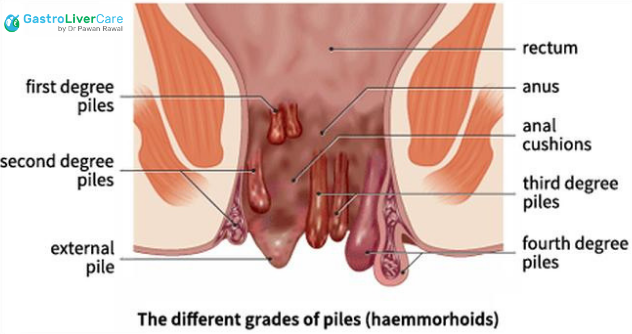Hemorrhoids or piles are a normal part of the anatomy and their presence does not imply a disease state. They are caused by enlarged blood vessels that cause small swellings, either inside or outside your rectum. The blood vessels become enlarged when subjected to pressure, for example, when straining to pass stools when constipated or during childbirth. They are more likely to occur if you are overweight, constipated, or elderly. They are usually a minor and temporary inconvenience. However, if symptoms are persistent your doctor should be able to offer advice and medication to help with piles.

Symptoms of Hemorrhoids / Piles:
– Swelling and irritation, in or around your rectum.
– Fresh, bright red blood on the toilet paper is a sign of internal hemorrhoid.
– External hemorrhoids can bleed, usually when rubbed by toilet paper or tight-fitting underwear.
– A thrombosed pile may feel like a painful lump.
How are hemorrhoids treated?
Most hemorrhoids get better within a few days without any specific treatment. Simple measures such as bathing in warm water or using a local cream or ointment can relieve some discomfort. Endoscopic treatment includes Injection therapy (Sclerotherapy), Band ligation, and Infrared coagulation. Surgical removal might be warranted in the case of recurring or very bothersome hemorrhoids.
When to consult?
In most cases, hemorrhoids are a temporary problem. If you notice dark blood mixed with your stools, experience pain or suffer excessive irritation or mucus leakage, you should see your doctor.
Prevention of piles
- Avoid constipation by eating plenty of fiber, including fresh fruit, vegetables, whole wheat bread, and cereals, and, drinking plenty of fluids
- Exercise regularly. This will also help to prevent constipation and ease the pressure on the hemorrhoids.
- Avoid using hard toilet paper, use soft paper or medicated wipes instead.
- Reduce discomfort by washing gently with warm water or sitting in a tub for 10 minutes several times a day. Using an ice pack can also help reduce pain and swelling.
- Do not scratch the area as this will make it more painful and uncomfortable.
- Wear loose-fitting underwear made from natural materials such as cotton.
- Avoid obesity
In conclusion, Hemorrhoids are a common medical condition, characterized by swollen blood vessels in the rectal or anal area. While often painful and uncomfortable, they are usually not a serious threat to one’s overall health. Treatment options range from lifestyle changes, dietary adjustments, and topical ointments to more invasive procedures in severe cases. Early diagnosis and proper management can alleviate symptoms and improve the quality of life for those affected by hemorrhoids.






